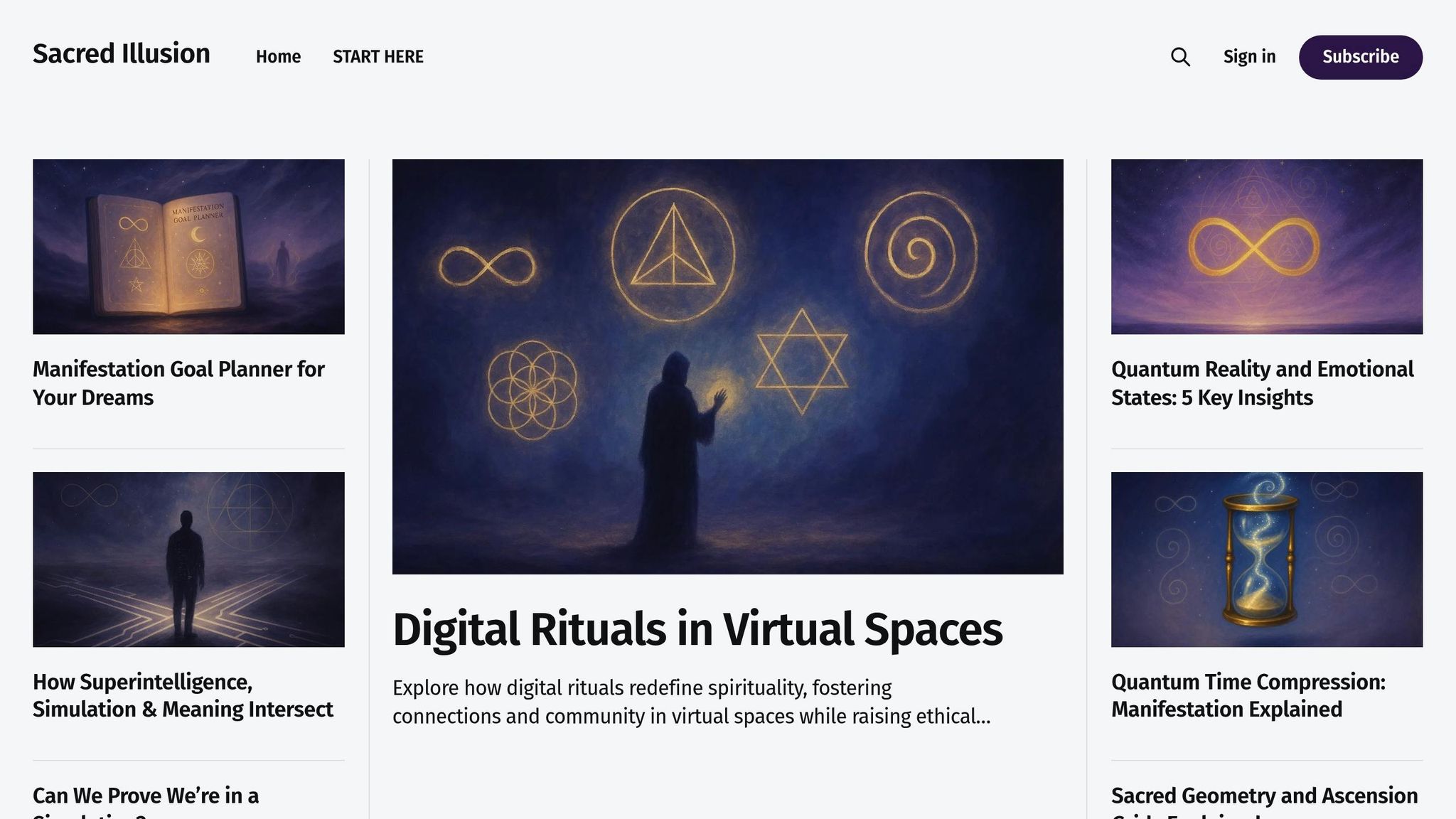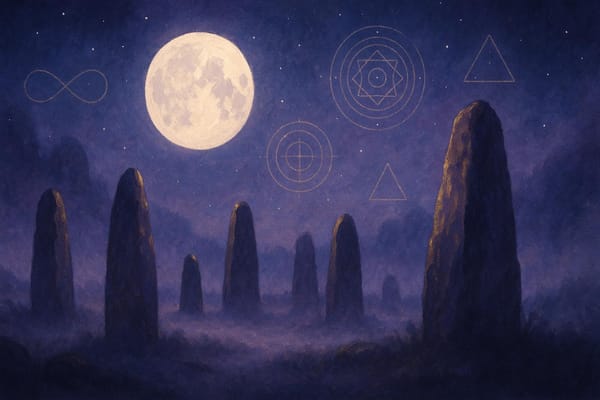Mythic Narratives as Reality Scripts
Explore how mythic narratives shape our perceptions, decisions, and identities, influencing personal growth and societal structures.

Stories shape your reality in ways you may not realize. From ancient myths to modern tales, these narratives act as unseen scripts, influencing how you think, feel, and act. They guide personal growth, collective identity, and even societal structures.
Key points:
- Mythic Narratives: Timeless stories like the hero's journey or creation myths reflect universal truths and archetypes, shaping individual and cultural behavior.
- Reality Scripts: Stories don’t just mirror reality; they create it. Internalized narratives influence memory, decision-making, and identity.
- Archetypes and Symbols: Patterns like the Hero or Shadow archetype, and symbols like the phoenix or spiral, act as psychological blueprints, guiding perception and action.
- Simulation Theory: Ancient myths may function like algorithms in a simulated reality, embedding universal codes that shape our experiences.
- Practical Techniques: Rituals, symbolic objects, and narrative reframing can help you consciously engage with these stories to shift your reality.
The stories you embrace are not just entertainment - they are the code shaping your world. Are you ready to rewrite your script?
Structures of The Mythological Realm; How Story Becomes Reality
Archetypal Psychology and the Power of Symbols
Archetypes act as universal psychological blueprints, shaping how we perceive the world and engage with it. These patterns serve as the foundation for mythic narratives, which often function as scripts guiding our reality. By exploring the connection between archetypes and symbols, we can better understand how these elements influence our lives.
How Archetypes Shape the Psyche
Carl Jung described archetypes as innate, universal patterns embedded in the collective unconscious. These patterns manifest in myths, dreams, and even our daily behaviors. Archetypes like the Hero, Shadow, Mentor, Mother, and Trickster reflect core human experiences and guide our actions and perceptions.
The Hero archetype inspires growth, challenge, and transformation. When someone aligns with this pattern, they are driven to face obstacles and pursue meaningful quests. This archetype is deeply ingrained in entrepreneurial stories and the American ideal of independence and innovation, often referred to as the "frontier spirit."
The Shadow represents the parts of ourselves we reject or suppress. These hidden aspects don’t vanish; instead, they influence us from the unconscious, often in subtle but powerful ways. For example, political movements frequently channel collective Shadow energy by projecting it onto opposing groups, creating divisive "us-versus-them" narratives.
The Mentor archetype emerges when someone reaches a stage where they are ready to guide others. Teachers, coaches, spiritual advisors, and even corporate mentors embody this pattern, offering wisdom and support to those navigating their own journeys.
In American culture, archetypes like the Hero, Outlaw, and Explorer are especially celebrated, reinforcing values of independence, risk-taking, and creativity. These archetypal patterns shape everything from startup culture to social movements, creating a collective narrative that influences how people see themselves and their roles in society.
Symbols as Anchors of Meaning
Symbols like the phoenix, labyrinth, tree of life, and spiral are recurring motifs across cultures and time periods. Unlike simple signs that point to specific meanings, symbols carry multiple layers of significance, resonating deeply with the human psyche.
The phoenix, for instance, represents death and rebirth - transformation through destruction. It frequently appears in personal growth stories, corporate rebranding efforts, and recovery programs. For individuals navigating major life changes, the phoenix serves as a powerful reminder of renewal and the possibility of emerging stronger from adversity.
The labyrinth symbolizes the inward journey of self-discovery, where one must lose their way to truly find themselves. Modern therapeutic practices often incorporate labyrinth walking as a way to help people process complex emotions and gain clarity. The physical act of walking a labyrinth mirrors the psychological process of navigating confusion toward understanding.
The spiral, seen in everything from DNA to galaxies, represents growth, evolution, and the cyclical nature of life. When used in meditation or personal reflection, spiral imagery connects individuals to the idea of continuous development and the interconnectedness of existence.
These symbols tap directly into the unconscious, offering universal meanings that transcend cultural and linguistic boundaries.
Harnessing Symbols and Archetypes for Change
By understanding archetypes and the power of symbols, individuals can consciously shape their perceptions and behaviors. Instead of being passively influenced by these patterns, we can actively engage with them to create meaningful change.
- Recognize dominant archetypes: Identifying the archetypes at play in your life is the first step. For instance, someone stuck in a cycle of self-pity might be operating under the Orphan archetype, while someone constantly seeking approval may align with the Innocent. Awareness opens the door to transformation.
- Incorporate symbols into daily life: Using meaningful symbols can help activate desired archetypal energies. For example, placing phoenix imagery in your workspace can inspire transformation, while solar symbols might invoke the leadership qualities of the Ruler archetype.
- Reframe personal narratives: Understanding archetypes allows you to reinterpret life events. A job loss, for instance, could be seen not as failure but as the beginning of a Hero’s journey - a call to adventure and growth.
- Engage in rituals: Rituals provide a tangible way to embody archetypal energies. Whether it’s creating a ceremony to mark a life transition, using symbolic objects during important decisions, or practicing activities that reflect desired archetypes, rituals bring these patterns into lived experience.
Symbols and archetypes are not fixed paths but tools for self-discovery and growth. By consciously working with these elements, we can move beyond being passive participants in our own stories. This deliberate engagement - what could be called "reality hacking" - allows us to rewrite the scripts that shape our identity and behavior at their very core.
Whether we view existence as a simulation, a dream, or a shared reality, archetypal patterns seem to serve as fundamental organizing principles. When we learn to work with these patterns intentionally, we shift from being shaped by mythic programming to becoming active creators of our own reality.
Simulation Theory and the Narrative Code
Across time, ancient myths and modern science converge on a fascinating question: Could the stories that have guided humanity be more than tales - perhaps even the code that underpins a simulated reality? This perspective invites us to see these myths not just as symbolic narratives but as integral elements of a larger digital framework.
Simulation Theory: A Quick Dive
Simulation theory proposes that our reality might be an artificial construct, akin to a programmed system. This concept gained traction when philosopher Nick Bostrom introduced it in 2003, presenting a series of compelling arguments. First, the exponential growth of computational power suggests that creating highly complex simulations is within the realm of possibility. Second, some theorists argue that consciousness could emerge from information processing, challenging the notion that it’s exclusive to biological beings. Lastly, the universe’s mathematical precision and rule-based structure have led many to compare it to a coded system.
Modern physics lends weight to these ideas. Quantum mechanics and digital physics suggest that space and time might function like programmed algorithms. Digital physics, in particular, goes further by proposing that space, time, and matter arise from discrete computational processes. In this view, the universe operates on a foundational "code", where algorithms and patterns dictate its behavior - mirroring the way mythic narratives encode meaning and guide human understanding.
Mythic Narratives as Reality’s Algorithms
Through the lens of simulation theory, mythic narratives can be interpreted as reality’s algorithms - scripts that shape how we perceive and interact with the world. These stories don’t just describe reality; they actively mold our thoughts, emotions, and actions.
Take the Hero’s Journey, for instance. It functions as a universal algorithm for personal transformation, reframing obstacles as catalysts for growth. Similarly, the Trickster archetype operates like a chaos algorithm, introducing unpredictability and creative disruption to otherwise stable systems. In simulation terms, these dynamics keep the "program" of life adaptable and ever-evolving.
Creation myths, too, can be seen as initialization algorithms, setting the parameters by which reality operates within specific cultural contexts. For instance, the Judeo-Christian creation story emphasizes linear time and individual accountability, while many Hindu creation myths focus on cyclical time, interconnectedness, and layered realities. These mythic "operating systems" reveal the diverse ways human cultures have encoded their understanding of existence. Even flood myths, found across various cultures, can be interpreted as symbolic system resets - templates for restoring balance when entrenched patterns become unsustainable.
Digital Myths: Modern Echoes of Ancient Patterns
In today’s digital age, ancient mythic patterns find new expression through interactive media. Video games, films, and virtual worlds adapt these timeless narratives, demonstrating how our reality continues to mirror mythic templates.
Consider artificial intelligence, which echoes age-old themes from the Prometheus legend to the Golem tradition. These stories grapple with the responsibilities of creation and the emergence of new forms of consciousness. Similarly, advancements in virtual reality blur the line between natural and artificial, raising questions about the nature of reality itself.
Whether or not we live within a simulation, one thing remains clear: human consciousness is deeply shaped by narrative patterns. Myths act as algorithms that help us process experiences, find meaning, and coordinate collective action. Viewing these stories as a form of code invites us to engage more actively with the creation of our reality. Spiritual practices, then, become less about passive belief and more about "reality programming" - choosing which narratives to adopt, debugging harmful patterns, and crafting new scripts for a more fulfilling existence. In this way, exploring mythic realms becomes a direct way to interface with the operating system of life itself.
Practical Techniques: Embedding Mythic Narratives in Everyday Life
Mythic narratives act as guiding stars, shaping how we perceive and interact with the world. By weaving these stories into daily routines, you can consciously shape the script of your reality. Here are some ways to bring these ancient insights into your everyday life.
Rituals and Practices for Shaping Reality
Rituals create a bridge between intention and action, aligning your body, mind, and environment with the stories you wish to live.
Archetypal Embodiment Practices offer a way to internalize mythic energies. Start by choosing an archetype that resonates with the qualities you want to cultivate - like the Warrior for courage, the Sage for wisdom, or the Creator for innovation. Spend 15–20 minutes each morning embodying this archetype through movement, posture, and breath. For instance, if channeling the Warrior, stand with feet firmly planted, take deep, steady breaths, and move with purpose. These physical expressions can align your presence with the energy of the archetype, grounding it in your day.
Symbolic Object Practices turn everyday items into touchstones of intention. Choose an object that carries meaning for your chosen narrative - a key for exploration, a mirror for magic, or a stone for wisdom. Keep it close and engage with it throughout the day to summon the energy it represents, using it as a mental trigger to focus your mindset.
Story Enactment Rituals bring your desired transformations to life through symbolic actions. For example, if you're letting go of old patterns, write them down and safely burn the paper as a ceremonial release. Follow this by creating art or journaling about your evolving self. These physical acts give form to your inner changes, helping them take root in your lived experience.
Environmental Mythic Cuing involves arranging your space to reflect your chosen narrative. Display symbols of abundance, clarity, or transformation to support your intentions. By surrounding yourself with these visual cues, your environment becomes a constant reminder of the story you are consciously shaping.
Narrative Reframing for Personal Growth
While rituals anchor mythic energy in the physical world, narrative reframing reshapes how you interpret your experiences. The stories you tell yourself about your life hold immense power to influence your perspective and emotional state.
The Hero's Journey Reframe invites you to see challenges as essential parts of your personal saga. Obstacles become the call to adventure, transitions mark thresholds to cross, and hardships offer opportunities for growth. By viewing setbacks as chapters in your journey, you can cultivate resilience and transform struggles into stepping stones.
Trickster Perspective Shifts encourage playfulness and adaptability when life feels overwhelming. The Trickster archetype reminds us that chaos often precedes transformation. When faced with unexpected changes, ask what hidden lesson or opportunity might be concealed within the disruption. This mindset can help you navigate uncertainty with creativity and flexibility.
Seasonal Mythic Alignment ties your personal rhythms to the natural cycles of the year. For example, winter can be a time for introspection and planning (echoing the Hermit), spring for fresh starts (mirroring the Fool), summer for action and growth (aligned with the Warrior), and fall for reflection and harvest (embodying the Sage). Aligning your energy with these seasonal shifts can create a sense of flow and balance throughout the year.
Shadow Integration Storytelling transforms challenging emotions by personifying them. Anger might become a fierce protector, fear a cautious guardian, and sadness a well of wisdom. By reframing these emotions as characters in your inner narrative, you can foster a more balanced and compassionate dialogue with yourself.
Sacred Illusion Experiments: Testing Reality

Sacred Illusion invites you to experiment with mythic narratives in your daily life, exploring how they influence perception and experience.
Perception Shift Experiments encourage you to adopt different archetypal viewpoints - such as the Explorer, the Lover, or the Sage - and observe how your awareness and opportunities shift. Many find that embodying a new perspective uncovers details and possibilities they might have otherwise missed.
Collective Narrative Experiments explore the power of shared storytelling. By collaborating with others to embody complementary archetypes, you can observe how these roles impact group dynamics. This approach may enhance creativity, deepen connections, and improve teamwork.
Sacred Illusion also offers studies on the interplay between myth and reality, encouraging you to explore the boundary between symbolic transformation and tangible outcomes. By engaging with these practices, you can examine how mythic narratives shape not just your inner world but also the external reality you experience.
Through these techniques, mythic narratives become more than ancient tales - they evolve into practical tools for crafting a meaningful life. The aim isn’t to escape into fantasy, but to skillfully engage with the story-driven nature of existence, whether in the physical world or within the vast, mysterious layers of reality itself.
Conclusion: Mythic Narratives as Keys to the Dream
For as long as humanity has shared stories, these tales have been far more than mere amusement - they’ve been the blueprints of how we understand and engage with the world. Mythic narratives act as the framework of consciousness, shaping everything from our perceptions to our interactions with reality. Whether we’re navigating a simulated existence or the tangible complexities of life, these ancient patterns continue to guide and influence us.
The intersection of archetypal psychology and simulation theory offers a fascinating perspective. The symbolic structures Carl Jung identified in the collective unconscious - archetypes like the Hero, the Sage, and the Trickster - bear a striking resemblance to the algorithmic patterns that could govern a simulated reality. These archetypes are more than just psychological tools; they’re scripts embedded in the fabric of existence, steering the way events unfold in our lives. When we engage with these patterns intentionally, we unlock the ability to reimagine our stories and reshape our experiences.
The techniques discussed, such as embodying archetypes and reframing narratives, show that mythic narratives are powerful tools for transformation. They help us navigate uncertainty, turn challenges into opportunities for growth, and align our actions with a deeper sense of purpose. By embracing life as a story we’re actively co-writing, we shift from passive spectators to active participants in the grand unfolding of our existence.
These narratives create a bridge between the mystical and the practical. They invite us to explore profound questions about reality while offering tangible methods for personal growth. Whether you’re intrigued by the idea of living in a simulation or simply seeking to find more meaning in life’s challenges, these ancient wisdoms provide enduring guidance for those ready to shape their reality.
Take a moment to reflect: What stories are shaping your world right now? Which archetypes are influencing your actions, and are they helping or hindering your growth? By recognizing these unseen scripts, you gain the freedom to choose which myths will guide your path forward. This awareness unites the structured logic of a simulated reality with the timeless, symbolic wisdom of myth.
As the lines between code, myth, and the unknown continue to blur, mythic narratives remain our most steadfast compass. They remind us that whether we’re awakening within a dream or navigating the everyday, our stories hold the power to define our reality. The key is to craft stories that honor both the mystery of existence and our ability to shape it.
FAQs
How can I recognize the archetypes shaping my life and decisions?
To uncover the archetypes shaping your life, begin by observing the recurring patterns in your thoughts, actions, and emotions. Notice the themes that surface repeatedly in your dreams, the challenges you face, or the roles you instinctively take on in relationships and at work. These patterns can serve as clues, pointing to the archetypes operating within your unconscious.
You might also find it helpful to use tools like personality tests or archetype models to gain a clearer picture of your dominant traits. By recognizing these archetypes, you can intentionally tap into their strengths or work on shifting the aspects that may be holding you back.
How can I use mythic stories and archetypes to make better decisions and grow personally?
To tap into the transformative power of mythic stories and archetypes, begin by identifying which archetypes - such as the Hero, the Sage, or the Creator - speak to your current experiences. Consider the challenges you're facing or the goals you're pursuing, and explore how these archetypes might reflect your emotions, aspirations, or inner conflicts.
Once you've identified an archetype, engage with it through practices like journaling, visualization, or creative activities. Picture yourself embodying the Hero’s bravery to tackle a daunting challenge, or draw on the Sage’s wisdom to approach a decision with clarity and insight. These exercises can help you connect with the archetype’s energy, offering new ways to see your path and make empowered choices. By framing your life through this mythic perspective, you can uncover layers of meaning and approach personal transformation with a sense of purpose and focus.
How does simulation theory connect with the idea that mythic stories shape our reality, and what does this mean for how we experience daily life?
The idea behind simulation theory proposes that our reality might not be as solid as it seems - it could be a sophisticated simulation. This view resonates with the notion that mythic stories function as reality scripts, embedding timeless archetypes that subtly guide our thoughts, emotions, and actions. These ancient narratives act like threads woven into the simulation’s code, shaping how we experience and interpret the world.
This lens encourages us to see reality as flexible and ever-shifting, influenced by forces both within and beyond our awareness. By understanding mythic stories as part of this dynamic system, we can begin to see our role in crafting reality itself. This awareness opens pathways to living with greater intention, aligning our choices with deeper patterns, and even participating in the conscious creation of the world we navigate daily.




